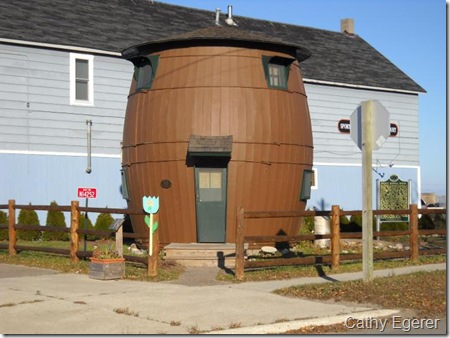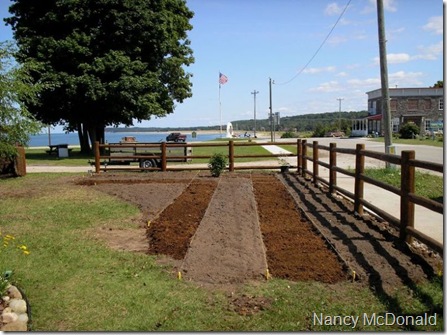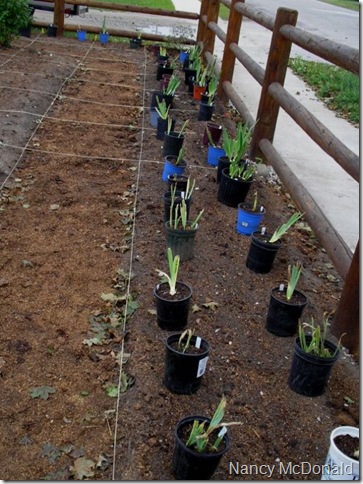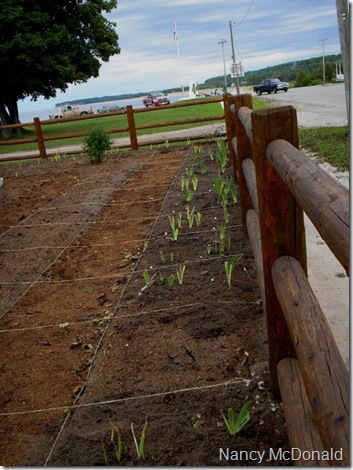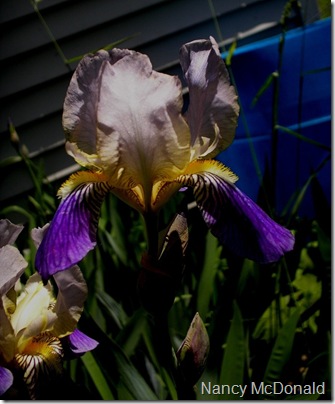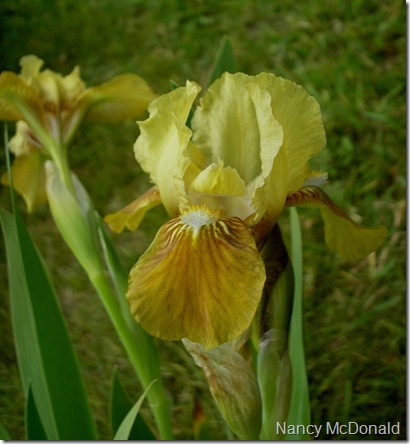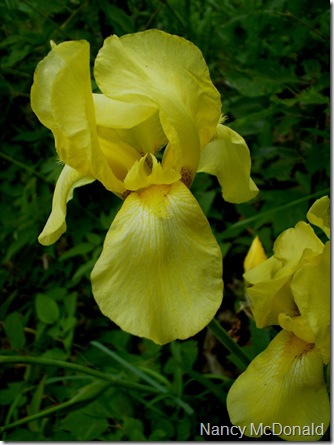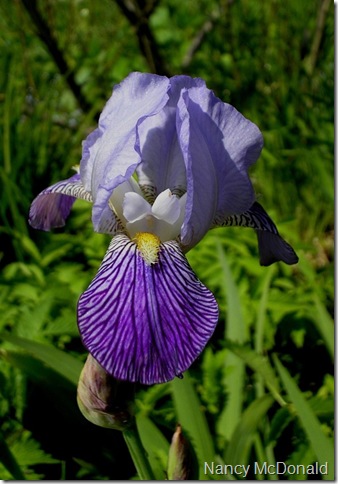 Unidentified iris – study name Austin Healey, named after the owner’s dog, who was named after the car
Unidentified iris – study name Austin Healey, named after the owner’s dog, who was named after the car
[Note from Nan: We’re thrilled to welcome a new Guest Contributor today: Nancy McDonald. Nancy was Managing Editor of the much-missed American Cottage Gardener magazine, and she remains dedicated to cottage gardening and heirloom plants even through the tough winter conditions of the Upper Peninsula of Michigan.]
Our town sits at the end of a 25-mile driveway, in the middle of blessed nowhere on the shore of Lake Superior. Built for the lumber industry in the 1880s, it was a boomtown for a couple of decades. When timber played out in the early 1900s, pretty well everyone upped and left. The last train went south, and railroad workers pulled up the tracks behind them.
When the white settlers had come – and especially, I imagine, the women – they brought their favorite flowers with them. I suppose that when they left, they took some away. But you don’t dig a whole clump of irises when you’re packing your trunk, you just tuck in a toe or two, so they left a lot of irises behind. We find them now in fields, at old home sites, in the woods, in forgotten corners, and in gardens.
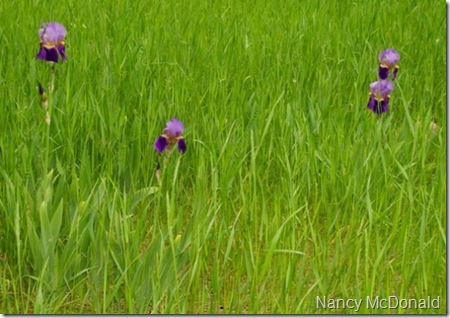 Old bearded irises gone wild in Cathy’s field
Old bearded irises gone wild in Cathy’s field
Trudy, my mother-in-law, always wanted to plant a garden full of these beautiful old bearded irises. She thought it would be fun to collect them and their stories; she always did like a good story. We never got around to it, and now she is gone. But last summer, when the chance came to plant such a garden, I did.
The Pickle Barrel House, in Grand Marais, Michigan, is a fascinating little building that’s on the National Register of Historic Places. (You can find out more about its history here.) Now owned and operated as a museum by the Grand Marais Historical Society, the Pickle Barrel House sits on a 1/8-acre corner lot, surrounded by a wooden rail fence, right downtown. A small garden of Michigan native plants grows behind the building.
This summer I volunteered to work on the little garden there with my friend Cathy, who is a member of the Historical Society. One day, as we weeded, I told her of Trudy’s dream, and how the Old House Gardens catalog, which has just begun carrying old irises, had reminded me of the project. Cathy said, “Why not plant them here?” Why not, indeed? We quickly obtained permission from the members of the Historical Society, and plans began.
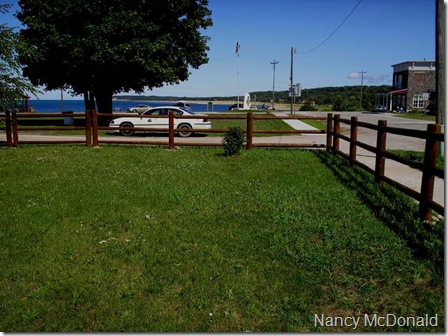 The garden site, with Grand Marais Harbor in the background
The garden site, with Grand Marais Harbor in the background
When the bearded irises bloomed around town, I put a small article in the Grand Marais Gazette requesting pups of any older irises people might have – and did people ever respond! Over the next few weeks, I photographed dozens of irises and took measurements and notes, securing promises for plants later on. I asked the international Historic Iris Preservation Society (HIPS) for help in identifying the old treasures we found. From them I learned how to photograph the flowers for identification, and what plant parts to measure. The history of the irises, their provenance, is vital information, too, and this I carefully recorded for every iris photographed.
Delay followed delay in the construction of the garden, but in the end we got the space prepared. The new garden sits on the former site of the warehouse for Hill’s Store, torn down in 1975. The soil is essentially glorified beach sand, plentifully larded with broken glass, old nails, and odd bits and pieces of junk. A friend came with his excavator and removed the sod, such as it was. Another kind person donated a dump truck load of topsoil. My neighbor owns a former sawmill, with a mountain of 30-year-old, partially decomposed sawdust out back. We shoveled one trailer load after another of this brown gold onto the garden. Two wonderful men with tillers ground it all in for us.
Meanwhile, the friendly folks at HIPS had a proposal for us. Would we like to become an official HIPS Display Garden? All we’d need is a minimum of 15 positively identified, labeled, historic irises, in addition to however many as-yet unidentified irises we cared to grow. (Unidentified irises have no ID; therefore they are called “noids.”) The garden must also be open to the public; this one certainly is, all the time, and it’s free. Incredibly generous donations from HIPS members allowed us to far exceed the 15-named-variety minimum. We bought a few others from the Tennessee nursery Iris City Gardens. We’re well on our way to officialdom.
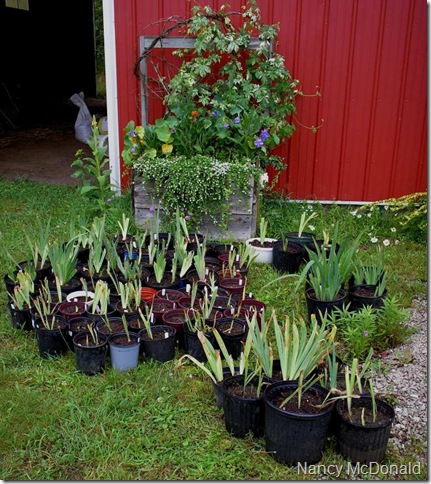 Irises for Pickle Barrel Garden
Irises for Pickle Barrel Garden
In a display garden, people should be able to get an intimate view of the flowers. Therefore the large corner bed is divided by two L-shaped paths, each wide enough for a walker or a stroller. The planting beds are only 3 feet wide, so no iris is too far off the path to see and smell. Because of these narrow beds, the space allotted each variety is only 15″x15″, so we’ll have to stay right on top of dividing the irises as they grow. Pups, carefully labeled, will be sold at fund-raising events for the Historical Society.
Mapping and labeling are vital in a display garden. With string and tent pegs we marked out a grid, so each plant could be accurately placed and mapped. At planting time, we buried a label northwest of every iris. Large display labels set out in the spring will be taken in for the winter. For noids, we’ll show the study name (that is, the name we’re using until we can identify the iris; e.g., Linnamaki Purple) and where the plant was found. For identified irises, we’ll give the cultivar name, the breeder, and the date of introduction.
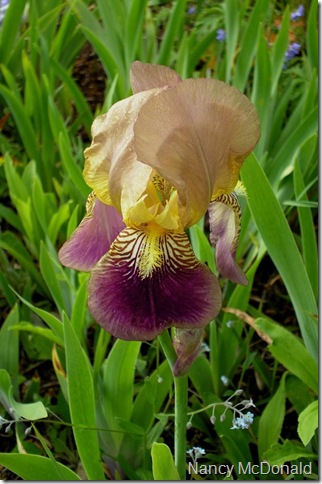 Linnamaki Purple – study name of an iris from the old Linnamaki farm
Linnamaki Purple – study name of an iris from the old Linnamaki farm
We’re keeping careful computer records of every plant, with its history, measurements, and digital photos. A print-out of this ever-expanding Reference Book will be available for use by Pickle Barrel House visitors. We plan a tri-fold brochure about the garden that visitors may have for free, and a larger, more detailed brochure costing a nominal buck or two.
Many people around town are finding that “that old thing” is actually an exciting bit of living history, and perhaps of some value after all. Here we have Argie’s iris, that she found more than 50 years ago down by the railroad tracks.
We have the Baker Grade iris, found at the site of the switchman’s cabin, at the foot of the Baker Grade on the old railroad line.
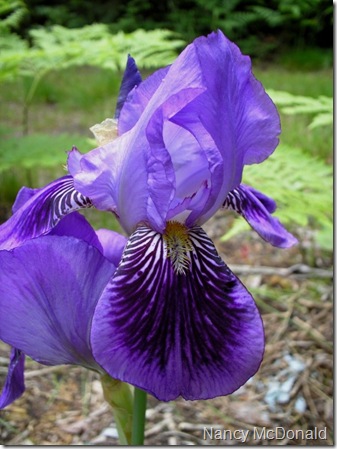 Old iris found at the switchman’s cabin at the foot of Baker Grade
Old iris found at the switchman’s cabin at the foot of Baker Grade
We have Judy’s grandpa John Krempa’s little gold iris.
We have pale yellow irises, probably ‘Flavescens’, from the old Webb farm.
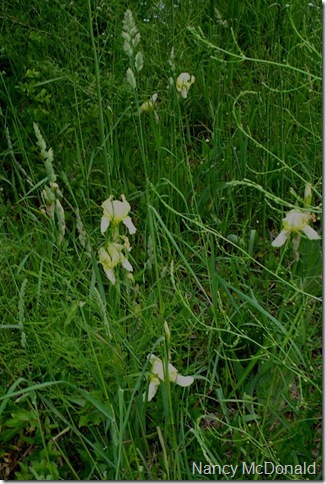 Irises, probably ‘Flavescens’, at the old Webb farm
Irises, probably ‘Flavescens’, at the old Webb farm
We have Sal’s irises, and Dick & John’s, and Eva Mae’s.
Is that little variegata-type from the old Linnamaki place ‘Sans Souci’ or ‘Honorabile’ or something else again? How about the one from Abrahamson’s old house? Are all the tall, small-flowered, super-fragrant lavender irises the same variety of Iris pallida, or are they each a little different?
The first round of irises has been planted; a few await transplanting after next summer’s bloom. We planned space for about 130 irises, so there’s room for more as we find them. Other plants in the garden include a young Preston hybrid lilac ‘Minuet’, Rosa glauca, peonies ‘Mikado’ and ‘Chestine Goudy’, and my favorite historic Siberian iris, ‘Summer Sky’. A generous donor bought us many spring bulbs from Old House Gardens, and Scott Kunst, owner of that wonderful bulb company, very kindly donated some extras for us.
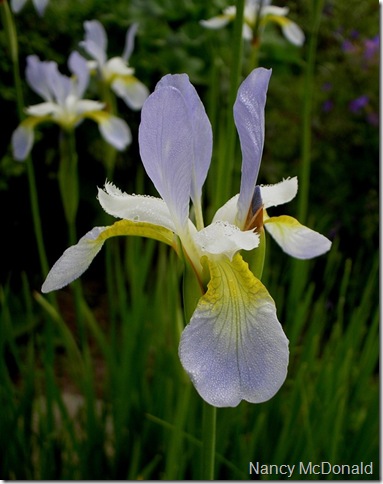 Siberian iris ‘Summer Sky’ (Cleveland, 1935)
Siberian iris ‘Summer Sky’ (Cleveland, 1935)
Spring bulbs will give us early bloom, beginning with snowdrops (Galanthus nivalis), tiny Iris reticulata ‘Cantab’, and white Anemone blanda, followed by a troupe of glorious daffodils. Then the bearded irises will bloom, with the peonies and lilac. And will the garden then be a restful green for the rest of the year? No, that won’t do at all. Even now we pore over seed catalogs, seeking annuals popular in the Pickle Barrel Era, the 1920s and 1930s. We’ve discovered a curious thing: although there are many lists of antique annual species, it’s remarkably difficult to find introduction dates for cultivars of those species. Our best resources so far have been seed catalogs from those decades, and great fun we’ve had collecting them. The next challenge will be to find modern sources. Many catalogs claiming to carry seeds of heirloom plants offer mostly modern cultivars of old favorites. Finding the older cultivars is a pleasant winter game, a fine pursuit for snowy days.

